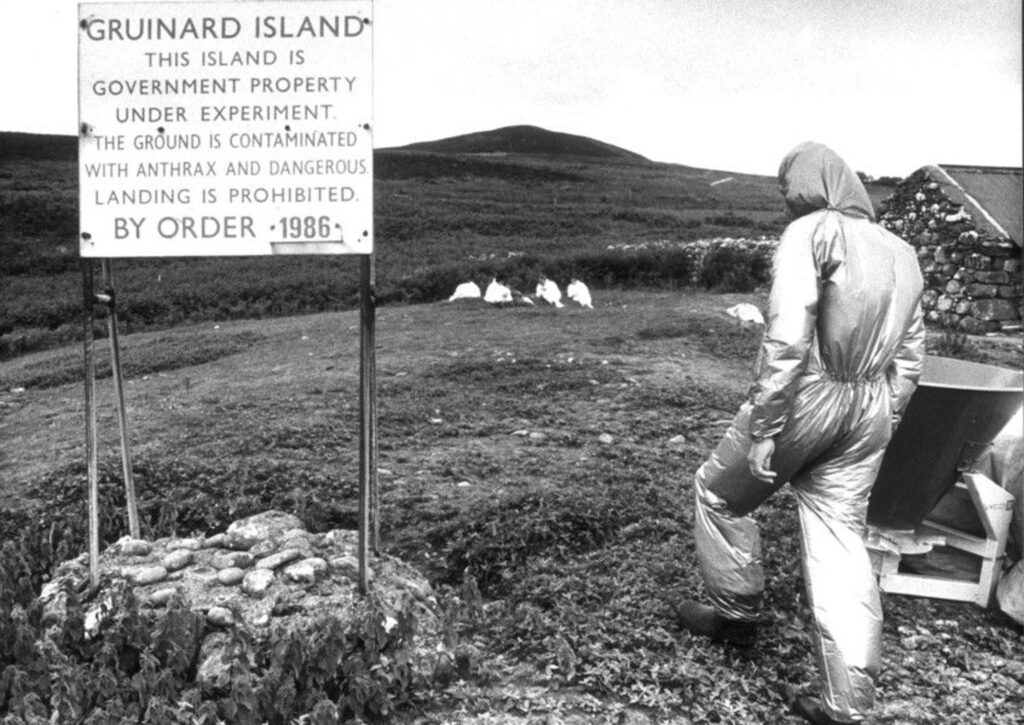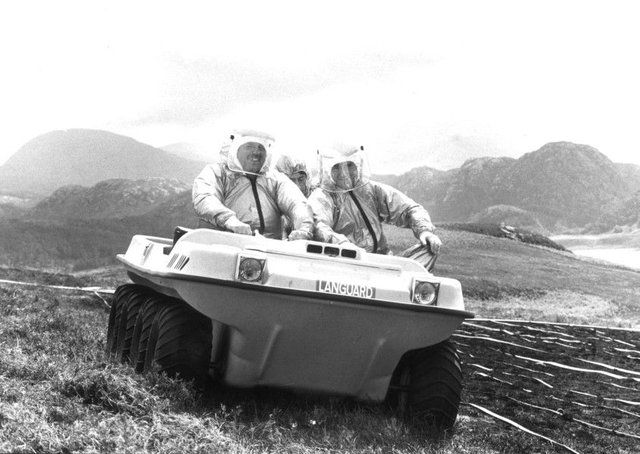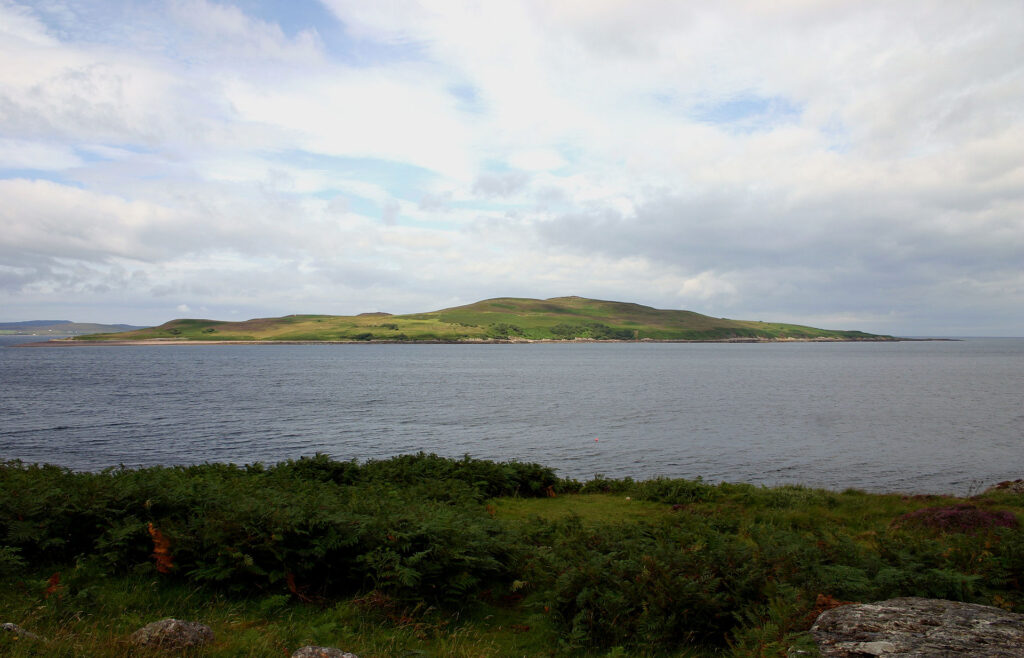‘Anthrax Island’: Britain’s Secret WWII Testing Ground for Biological Warfare

Scotland’s Gruinard Island, better known as ‘Anthrax Island’, is a frightening example of the catastrophic repercussions of biological warfare. From 1942 to 1943, the British tested the affects of anthrax on the small, unassuming island off the coast of Gruinard Bay… and paid the price for the next 48 years.
What is Anthrax?
Classified as an infectious disease, anthrax has been around for thousands of years. Possible references can be found in numerous historical sources including Homer’s The Iliad (from around 700 BCE) and poems written by Virgil (from around 70-19 BCE). It is also thought that anthrax was the cause of the fifth plague in Egypt, as told in the Book of Exodus.

Humans are most likely to be infected by anthrax by coming in contact with a contaminated animal, but it can also be found in food and water, or naturally in soil. Today, anthrax is most commonly found in Central and South America, sub-Saharan Africa, central and southwestern Asia, southern and eastern Europe, and the Caribbean. In the United Kingdom, the last outbreak of anthrax in livestock occured in 2015, but it’s generally considered relatively rare in the country.
The symptoms of anthrax in humans are horrifying and can take one day to two months to fully appear. These include but are not limited to: ulcers with a black centre, a high fever, confusion/dizziness, vomiting (often bloody with gastrointestinal anthrax), sore throat, diarrhoea (again.. often bloody), and neck and glands swelling. If left untreated, anthrax spreads throughout the body and can become lethal very quickly. Undoubtedly an incredibly terrible way to die.
Operation Vegetarian
With war crimes abound during WWII, even the British looked to the use of an incredibly unethical solution to ending the war – biological warfare. As the threat of a Nazi invasion grew closer to reality in the early 1940s, Winston Churchill ordered Porton Down (originally established during WWI to study chemical weapons) to investigate the use of anthrax and the affects that it had on humans and livestock. The hypothetical plan was to drop anthrax laced “cattle cakes“, which are fed to cows, over Germany’s fields. If the livestock then ate the infected food, the infection would be passed on to any humans that consumed the meat. Or alternatively, the cow would die before the meat was consumed, which would still have a high affect on the country’s meat supply. Once the German’s realised their meat was infected, even eating non-infected meat would be met with suspicion and fear. The project was, unsurprisingly, dubbed “Operation Vegetarian”. And for something this large-scale and deadly, thorough testing was required. But where?
Enter ‘Anthrax Island’
Operation Vegetarian needed an isolated testing ground a safe distance away from the general population (as well as prying eyes) and Gruinard Island, sitting 1km off the Scottish coast, was considered the ideal location. The island was purchased from the owner for £500 and the government vowed to return the land to the original owner or the owner’s descendants for the same price when it was deemed safe. Porton Down designated the island Base X and the testing of Operation Vegetarian began in 1942.
With the assistance of the Navy, researchers brought eighty sheep to Gruinard Island where they were tethered down in groups. Anthrax bombs were then detonated near the sheep to determine if anthrax spores could survive the bombing. Researchers discovered that the spores could in fact survive when, only three days after being infected, all of the sheep were dead. The tests also concluded that anthrax spores could remain in the soil for decades. Additional tests took place on the island in the summers of 1942 and 1943 with a total of 22 anthrax bombs releasing 300 thousand billion spores and killing an unknown amount of sheep in the name of biological warfare.
The testing for Operation Vegetarian wasn’t all smooth sailing. To dispose of the sheep carcases, researchers gathered them into caves on Gruinard Island, which were then bombed to bury to remains. However, the blast from the bombs unintentionally thrust some anthrax infected carcases out into the sea. It’s said that 62 animals on the mainland near Gruinard Bay died, including seven cattle, two horses, three cats, and over 20 local sheep after a dog ate an infected Gruinard Island carcass that washed ashore in 1943. And when documents were declassified in 1999, they showed that some scientists working on the island were gravely concerned that their research would cause an epidemic. It’s also alleged that teenagers with little experience were hired by Porton Down to help with the experiments. A small sample of the sketchy details surrounding an even sketchier government-led study.
However, the story of Gruinard Island is best told through declassified footage of the experiments now widely available to the public. A word of warning, the video below is an animal lover’s nightmare and contains scenes of animal testing, death, and distress.
Operation Dark Harvest and the Decontamination of ‘Anthrax Island’

After a series of tests in 1971, scientists determined that while there were no longer anthrax spores on the surface, the soil was still infected six inches underground. Signs were placed along the coast and on the island warning visitors that the ground contained anthrax and the site was forbidden. At the time, this was pretty much all the government did to ‘fix’ the problem of the abandoned and deadly island. So it’s unsurprising that in 1981 a group emerged demanding the government officially decontaminate the island. And they had a creative way of getting their point across.
According to an article in Time from 1981, Operation Dark Harvest (or Dark Harvest Commando) demanded that the government made a real effort to decontaminate the island by burying the infected soil under layers of concrete, sand, and other materials, or by removing it from the island and burying it at another site. They also suggest soaking the entire island in a potassium permanganate solution and even raising the temperature on the island to 1,000° C for two minutes in order to kill the remaining anthrax spores. The group then claimed to have landed on the island, collected 300lbs of the infected soil for the purpose of distributing it to key locations around the country. This is where the line between ‘protest’ and ‘terrorism’ becomes a bit murky.
The first package of “seeds of death”, weighing 10lbs, was delivered near Porton Down. Dark Harvest Commando’s statement on the matter read “Porton Down has just received a gift from Gruinard Island, the first of many”. When the soil was tested it was found to contain anthrax spores. Another package of soil was delivered to Blackpool where the Conservative Party was holding a conference. But while the soil was similar to that found on Gruinard Island, it did not contain anthrax. There were also unconfirmed rumours that other bags of soil were delivered (one allegedly to Prince William) but only the Porton Down and Blackpool packages are known to be true. The individuals behind Operation Dark Harvest were never identified, but some believe it was a group of locals near Gruinard Island who were tired of living near a dangerous, anthrax contaminated site.

Whether or not the threat successfully swayed the government, a clean-up effort began later that year. The topsoil was removed and the remaining soil, covering 196 hectares, was sprayed with 280 tonnes of formaldehyde solution that had been diluted in sea water. To test the long term effects of the decontamination, a flock of sheep was left on the island. Four years later in 1986 the sheep were found to have survived, happy and healthy.
After being quarantined for 48 years, Gruinard Island was officially declared decontaminated on 24 April 1990. To announce the safety of the long forbidden island, junior defence minister Michael Neubert visited Gruinard Island and was photographed removing the warning signs.
But not everyone felt that the island was safe for humans and animals. In 2001, archaeologist Dr Brian Moffat told the BBC that his team had found buried anthrax spores at a medieval hospital excavation near Edinburgh. He warned that since those anthrax spores had survived hundreds of years that the same was possible for Gruinard Island. He said, “I would not go walking on Gruinard. If anthrax is still active at [the medieval hospital site], there is no reason to suppose it has not survived on more recent sites. It is a very resilient and deadly bacterium.”
Who Owns Gruinard Island today?
The decontamination of Gruinard Island understandably garnered a ton of press. But because of the extensive media coverage, misinformation was bound to slip through the cracks, and in a world before the internet misinformation was difficult to correct swiftly.
As previously mentioned, the island was originally purchased from the owners for £500 and, according to the contract, would be resold to the family or the heir of the family for the same price. However, the press spread the story that Gruinard Island was for sale for the very low price of £500 to absolutely anyone who wanted it. Obviously this was a massive bargain (and entirely false), so various British government departments began receiving requests from all over the world to buy the small piece of Scottish land. An individual from Australia even wrote to the Prime Minister (Margaret Thatcher, at the time) offering to buy the island for £1000, doubling the ‘asking price’. Despite all the confusion, the island was already sold back to the heir of the original family, to the great disappointed of many keen international and local buyers. To hear more about this amusing story of Gruinard Island’s re-emergence from the iron grip of the government, check out Tom Scott’s Video ‘The Accidental Rush for Anthrax Island‘ on YouTube.
And finally, to answer a question I’m sure you’re dying to ask — can you visit the former ‘Anthrax Island’ today? Unfortunately the answer is a disappointing ‘no’. The current owners have asked that people refrain from travelling to their island, which I encourage people to continue respecting. And according to Dark-Tourism.com, there really isn’t anything worth seeing on Gruinard Island anyway. While there is apparently a healthy population of sheep and rabbits… that’s really it. Gruinard Island is, however, so close to the shore that it is visible to anyone driving down the A832 from Gairloch. So if you’re in the area, consider driving by and taking a quick look at the tiny piece of land that put a spotlight on the long-term horrors of biological warfare.
Sources and Additional Reading
Amusing Planet – The Dark Legacy of Gruinard Island
BBC News – Britain’s ‘Anthrax Island’
CBS News – Tourist Temptation: Anthrax Island
Centers for Disease Control and Prevention – Anthrax
Dark-Tourism.com – Gruinard Island, Scotland
GOV.UK – The Truth About Porton Down
History of Yesterday – Operation Dark Harvest – The story of Scotland’s ‘Anthrax Island’
History of Yesterday – Why Winston Churchill Stopped Operation Vegetarian
Science History – A Brief History of Chemical War
Time – Biological Warfare: Dark Harvest (from 1981)
The Scotsman – The Scottish ‘Anthrax Island’ poisoned by the government
YouTube – Tom Scott – The Accidental Rush for Anthrax Island
Wikipedia – Gruinard Island

